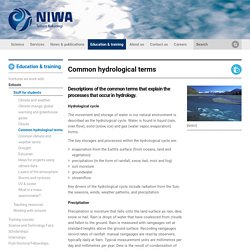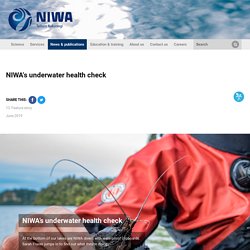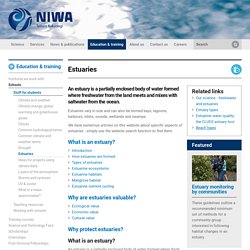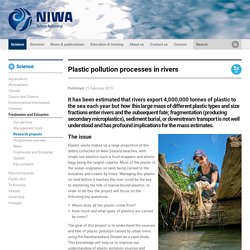

Common hydrological terms. Descriptions of the common terms that explain the processes that occur in hydrology.

Hydrological cycle The movement and storage of water in our natural environment is described as the hydrological cycle. Water is found in liquid (rain, river flow), solid (snow, ice) and gas (water vapor, evaporation) forms. The key storages and processes within the hydrological cycle are: evaporation from the Earth's surface (from oceans, land and vegetation)precipitation (in the form of rainfall, snow, hail, mist and fog)soil moisturegroundwaterstreamflow.
Key drivers of the hydrological cycle include radiation from the Sun, the seasons, winds, weather patterns, and precipitation. Precipitation Precipitation is moisture that falls onto the land surface as rain, dew, snow or hail. Evaporation Evaporation is the transfer of water from liquid to vapour. Soil moisture Soil moisture is water held in soil layers above the level at which groundwater (see below) occurs. Groundwater Streamflow Runoff Hydrograph Low flows. NIWA's underwater health check. LakeSPI has been used to assess the condition of 305 of New Zealand’s 3,820 lakes, with many of them, such as the Rotorua Te Arawa lakes, being surveyed multiple times.

The Ministry for the Environment uses the data to help describe the state of our freshwater, and it links directly to the Land And Water Aotearoa database, which also uses StatsNZ data collected by NIWA and regional councils. View lake water quality statistics Bay of Plenty Regional Council’s senior biosecurity officer Hamish Lass says LakeSPI has proved invaluable. “It gives us trends over time which show where we’ve got issues in some lakes, and where other lakes are getting better through good management. Life in fresh water. New Zealand’s lakes, rivers and ponds are home to many living things, although some are so small we can’t see them.

They include plants, snails, insects, shellfish and fish. Freshwater ecosystems The things that live in and around fresh water form communities or ecosystems. They depend on each other for survival. The freshwater food chain The plants and animals in the freshwater ecosystem are linked in a food chain: Millions of tiny plants use sunlight to grow. Plants Plants are the first link in the food chain. Phytoplankton are one type of algae that live in the water, while other types of algae live on lake and river beds. Some mosses and ferns grow in lakes or slow-moving rivers. Animals without backbones (invertebrates) Freshwater invertebrates include sponges, worms, snails, insects such as dragonflies, and shellfish.
In turn, invertebrates are eaten by fish and birds. Fish Surviving in fresh water Insects, fish and other species have features that help them live in fresh water. Estuaries. An estuary is a partially enclosed body of water formed where freshwater from the land meets and mixes with saltwater from the ocean.

Estuaries vary in size and can also be termed bays, lagoons, harbours, inlets, sounds, wetlands and swamps. We have numerous articles on this website about specific aspects of estuaries - simply use the website search function to find them. What is an estuary? Why are estuaries valuable? Why protect estuaries? What is an estuary? Plastic pollution processes in rivers. It has been estimated that rivers export 4,000,000 tonnes of plastic to the sea each year but how this large mass of different plastic types and size fractions enter rivers and the subsequent fate; fragmentation (producing secondary microplastics), sediment burial, or downstream transport is not well understood and has profound implications for the mass estimates.

The issue Plastic waste makes up a large proportion of the debris collected on New Zealand beaches, with single use plastics such a food wrappers and plastic bags being the largest culprits. Most of the plastic in the ocean originates on land, being carried to the estuaries and coasts by rivers. Managing this plastic on land before it reaches the river could be the key to stemming the tide of marine-bound plastics. In order to do this the project will focus on the following key questions: Where does all the plastic come from?